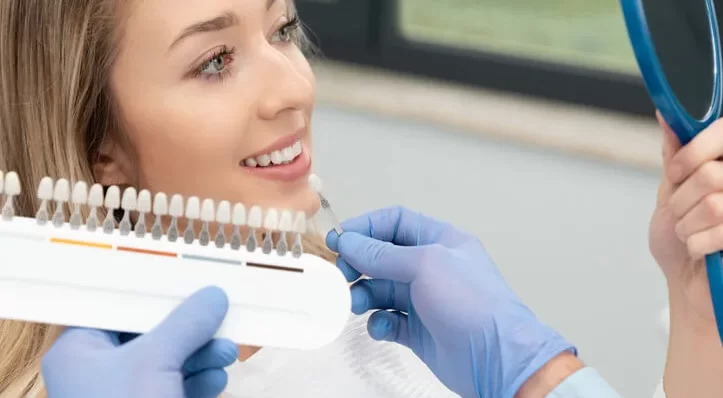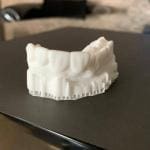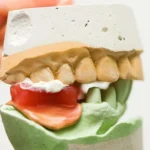In the field of dentistry, achieving seamless and natural-looking restorations is pivotal for patient satisfaction and successful outcomes. One of the critical aspects in this pursuit is shade matching, an intricate process involving the selection of the most appropriate color for dental restorations to blend seamlessly with the patient’s natural dentition. This artful skill combines scientific knowledge, visual acumen, and advanced technology to create harmonious and aesthetically pleasing dental restorations.
Understanding Shade Matching
Shade matching involves the selection of a restorative material that closely matches the color, translucency, and texture of natural teeth. This process is fundamental in various dental procedures, including crowns, bridges, veneers, and composite fillings. Achieving an accurate shade match is crucial, as even a slight discrepancy can result in an unnatural appearance, leading to patient dissatisfaction.
Factors Influencing Tooth Color
Numerous factors influence the color of natural teeth, making shade matching a challenging yet vital aspect of restorative dentistry. These factors include:
- Hue, Value, and Chroma
- Lighting Conditions
- Age and Health
- Individual Variations
Hue, Value, and Chroma
- Hue: Refers to the specific color tone (e.g., yellow, gray, reddish).
- Value: Represents the lightness or darkness of the color.
- Chroma: Indicates the intensity or saturation of the color.
Lighting Conditions
Natural and artificial lighting significantly affect the perception of tooth color. Dentists use various lighting sources, such as daylight, fluorescent, and LED, to assess shades accurately.
Age and Health
Tooth color varies with age, and factors like enamel thickness, transparency, and underlying dentin affect the overall appearance.
Individual Variations
Each person’s teeth have unique characteristics, including texture, translucency, and subtle color variations.
Techniques for Shade Matching
- Visual Method
- Digital Shade-Matching Devices
- Spectrophotometry
Visual Method
Dentists initially assess the tooth shade visually, comparing it to shade guides that simulate natural tooth colors. These guides consist of a range of shades, allowing dentists to match the closest shade to the patient’s teeth.
Digital Shade-Matching Devices
Advanced technology has introduced digital devices that aid in shade selection. These devices capture images of the teeth and analyze the color digitally, providing a more precise shade match.
Spectrophotometry
Spectrophotometric devices measure the reflectance of light from the tooth’s surface, providing detailed information about its color properties, including hue, value, and chroma.
Challenges in Shade Matching
Despite technological advancements, several challenges persist in achieving precise shade matching:
- Subjectivity
- Environmental Factors
- Material Selection
Subjectivity
Shade matching remains subjective, relying on the dentist’s experience, perception, and skill in interpreting color.
Environmental Factors
Lighting conditions, variations in ambient light, and the surrounding environment can impact shade perception, leading to discrepancies in color matching.
Material Selection
Different restorative materials possess varying optical properties, making it challenging to match the color of natural teeth accurately.
Strategies to Enhance Shade Matching Accuracy
- Training and Education
- Utilization of Technology
- Communication with Patients
Training and Education
Continuous education and training programs help dentists refine their skills in shade matching, improving their ability to perceive and replicate natural tooth colors.
Utilization of Technology
Incorporating advanced digital tools and spectrophotometric devices can enhance accuracy and consistency in shade matching.
Communication with Patients
Engaging patients in the shade selection process and managing their expectations play a crucial role in achieving satisfactory outcomes.
Shade Categories
In dentistry, shades are categorized based on various attributes of tooth color, including hue, value, and chroma. Understanding these shade categories is crucial for achieving accurate and aesthetically pleasing dental restorations. Here are the primary types of shades considered in dentistry:
Hue
- Yellow Shades
- Gray Shades
- Reddish or Brown Shades
Yellow Shades
Yellow hues are common in natural teeth. Variations in yellow shades are typical and contribute to the overall warmth of a smile.
Gray Shades
Grayish hues might result from aging, trauma, or certain medications. They present challenges in shade matching due to their unique color properties.
Reddish or Brown Shades
Teeth may have reddish or brownish hues due to underlying factors like genetics, diet, or staining. These shades require careful consideration during matching.
Value
- Light Shades
- Medium Shades
- Dark Shades
Light Shades
Lighter shades are characteristic of younger individuals or specific areas of teeth, like the incisal edges. Achieving the right level of translucency is crucial for lighter shades.
Medium Shades
The majority of natural teeth fall within the medium range. These shades balance both brightness and warmth, making them relatively easier to match.
Dark Shades
Darker shades may result from factors like aging or certain habits. Accurate replication of translucency and depth is essential for darker shades.
Chroma
- High Chroma Shades
- Low Chroma Shades
High Chroma Shades
These shades possess intense color saturation and are often seen in healthy, vibrant natural teeth. Achieving the right level of intensity without appearing artificial is critical.
Low Chroma Shades
Colors with low chroma appear more muted or desaturated. Replicating subtle variations without making the restoration look dull is challenging.
Special Considerations
- Translucency
- Fluorescence
Translucency
Natural teeth exhibit varying levels of translucency, allowing light to pass through. Mimicking this translucency is crucial for a realistic appearance in restorations.
Fluorescence
Fluorescence refers to the ability of a tooth to emit light when exposed to certain wavelengths. Replicating fluorescence is essential for natural-looking restorations, especially under different lighting conditions.
Shade Guides
Dental shade guides categorize various shades based on these attributes. They typically consist of tabs or blocks representing a range of hues, values, and chromas. Dentists use these guides as a reference to select the closest match to a patient’s natural tooth color.
Components of a Shade Guide
- Tabs or Blocks
- Shade Variations
- Organized Arrangement
Tabs or Blocks
These are the individual components of the shade guide, each representing a unique tooth shade. They are made from materials such as porcelain, composite resins, or acrylics, mimicking the appearance of natural teeth.
Shade Variations
Shade guides usually contain multiple tabs or blocks arranged in a systematic order, showcasing a wide range of color variations. The guide organizes these variations based on hue, value, and chroma.
Organized Arrangement
Shade guides are organized typically from lighter to darker shades and may include subdivisions or groupings based on color families (e.g., yellow, gray, reddish hues).
How Shade Guides Are Used
- Comparison
- Lighting Conditions
- Communication
Comparison
Dentists use shade guides by visually comparing the tabs to the patient’s natural teeth under various lighting conditions. They assess which tab closely resembles the color of the natural teeth.
Lighting Conditions
Dentists often use different types of lighting, such as natural daylight or artificial light, to evaluate shade matches more accurately. This helps account for variations in color perception.
Communication
Shade guides serve as a communication tool between dentists and dental laboratories. Dentists note the selected tab or tabs from the shade guide when communicating with lab technicians to ensure the accurate fabrication of dental restorations.
Variations and Updates
- Manufacturer-Specific Guides
- Digital Shade Guides
- Updates and Expansions
Manufacturer-Specific Guides
Different dental material manufacturers may offer their own shade guides with unique tab configurations and color representations.
Digital Shade Guides
Some advanced shade-matching systems utilize digital technology, allowing dentists to capture images of the patient’s teeth and compare them digitally to a database of shades, enhancing accuracy and efficiency.
Updates and Expansions
Shade guides evolve and expand over time to encompass a broader spectrum of shades, improving the precision of shade matching.
Conclusion
Mastering shade matching in dentistry is a multifaceted endeavor that blends artistry and science. Dentists must navigate through various complexities, considering individual variations, technological advancements, and environmental factors to achieve optimal aesthetic results. Continuous advancement in technology, coupled with ongoing education and refinement of techniques, will further elevate the accuracy and precision of shade matching, ultimately enhancing patient satisfaction and the overall quality of dental restorations.





